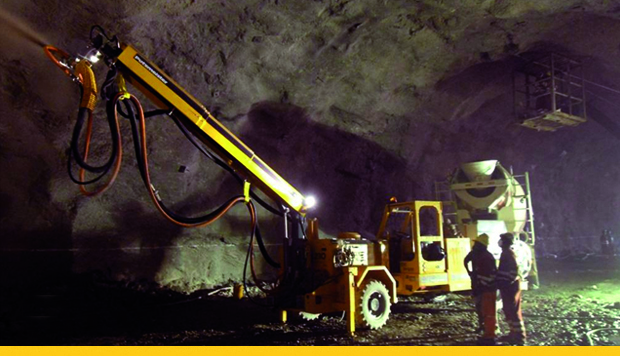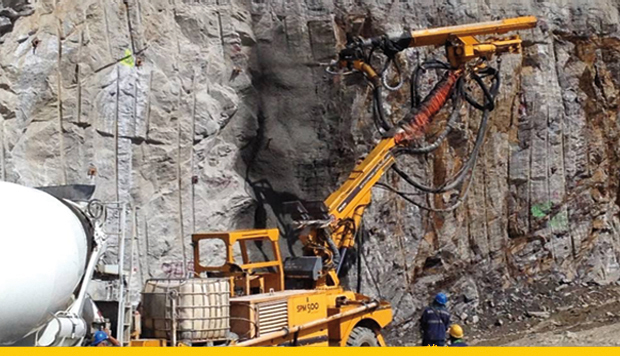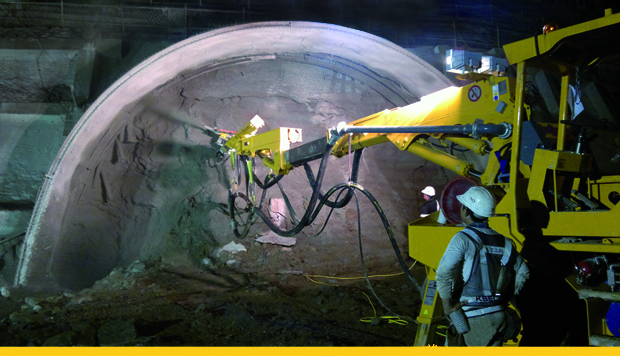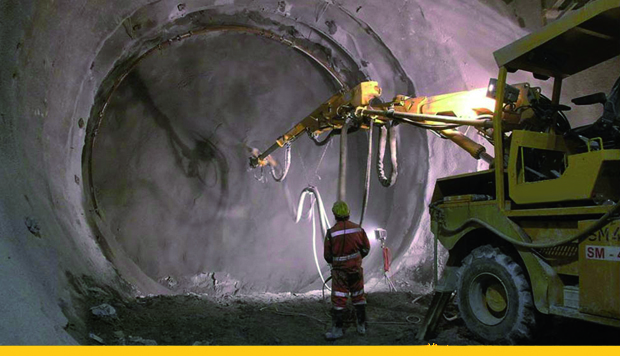Falling and moving rock is one of the major causes of death in underground works. In South Africa for example, the fatalities caused by falling rock in underground mines ascended to 30 % in 20141.
6 reasons why mechanized shotcreting is safer than manual application
1. Work outside the danger zone
As all equipment components are operated by remote control, the operator can work from a secure area that already disposes of the required support to prevent falling rock.
2. Fewer workers at the excavation face
Mechanized shotcrete equipment requires fewer operators than manual application, which implies fewer people working in areas of major risk.
3. Maintain your feet on the ground
The spraying arm allows shotcrete application beyond the manual spraying reach, without scaffolding and platforms that imply the risk of falling down or getting hit.
4. See better
The working lights of the concrete spraying equipment provide a synchronized illumination with the application, whereas manual application requires external illumination.
5. Work in a healthier way
The mechanization improves the working conditions by reducing the physical effort of the operator and the exposure to dust and rebound.
6. Obtain higher quality support
Being exposed to less stress, the operator is able to concentrate fully on his work, which leads to a higher quality shotcrete support and therefore improves security.
What is the future of safety in the concrete spraying process?
Currently, there is no global norm for the security of shotcrete in underground works. Yet there are some guidelines2 which were developed by organizations often referred to on a global level, and in some cases there are special regulations for particular countries.
Concerned about the safe and correct application of shotcrete, among others, the Instituto del Cemento y del Hormigón de Chile (ICH) is working on standardizing the shotcreting process in cooperation with EFNARC (European Federation for Specialist Construction Chemicals and Concrete Systems) and the American Concrete Institute (ACI).
This standardization aims at reducing the personnel working on ground support and creating procedures that prevent any kind of improvisation in the concrete spraying process. For this purpose, the three main parameters of shotcreting have to be aligned: material, equipment and personnel.
This requires materials to be selected according to the recommendations of the responsible project engineer, the latest technology in spraying equipment and, above all, well-trained personnel for equipment operation and maintenance, correct shotcrete application and the right reaction when exposed to challenging situations underground.
Have a look at our operator training, nozzlemen courses and service training.
Sources:
1 Chantelle Kotze, “Chamber of Mines: Safety focus reduces fatalities”, Mining Review 26 March 2015, http://www.miningreview.com/chamber-of-mines-safety-focus-reduces-fatalities/
2 Sergio García, “Shotcrete: Estandarización de procesos”, Revista EMB Construcción August 2013,http://www.emb.cl/construccion/articulo.mvc?xid=2728&edi=133&xit=shotcrete-estandarizacion-de-procesos
Guidelines:
EFNARC. 2015: Introduction to Nozzleman Certification, European Specification for Sprayed Concrete, Guidelines to the Sprayed Concrete Specification
ACI. 2015: Specification for Shotcrete, Guide to Shotcrete, Guide for Specifying Underground Shotcrete
ICH. 2015: Guía Chilena de Hormigón Proyectado – Shotcrete










